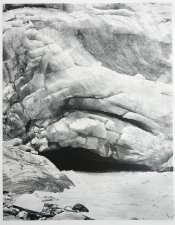I've never shot glaciers before, but here's what I'm thinking anyway. I'd suggest using a long lens. I imagine they're a bit like mountains in that the impulse is to use a wide angle to capture their grandeur, but that usually results in pictures of small looking mountains. It also helps to get things in the pictures that act as scale reference points, like people, plants, or animals, so you can get a sense of the scale. You can still use a normal and wide angle lens for certain things, but will probably find longer lenses more useful.
And of course since everything will be white(ish), you'll need to take that into consideration while metering. Otherwise you run the risk of underexposing everything if you're not using an incident meter.
And with the cold, it might be a good idea to test your camera in some cold weather first. The cold can slow down lubricants and cause shutters to jam or shutter speeds to slow. So it might be a good idea to find out how your camera reacts to those conditions first. I know some people who frequently photograph in cold environments will use special lubricants in their cameras to keep them running smoother in below freezing conditions. If you're using a digital camera or anything with batteries, it's a good idea to keep the batteries warm, which often means keeping them close to your body and not in the camera. I've been in cold weather conditions before where all of my electronics stopped working because I kept them in outside coat pockets instead of near my body where my body heat can keep them from freezing. But I don't know how cold it gets where you're going or how long you'll be exposed to the cold. So that may not even be an issue for you.







